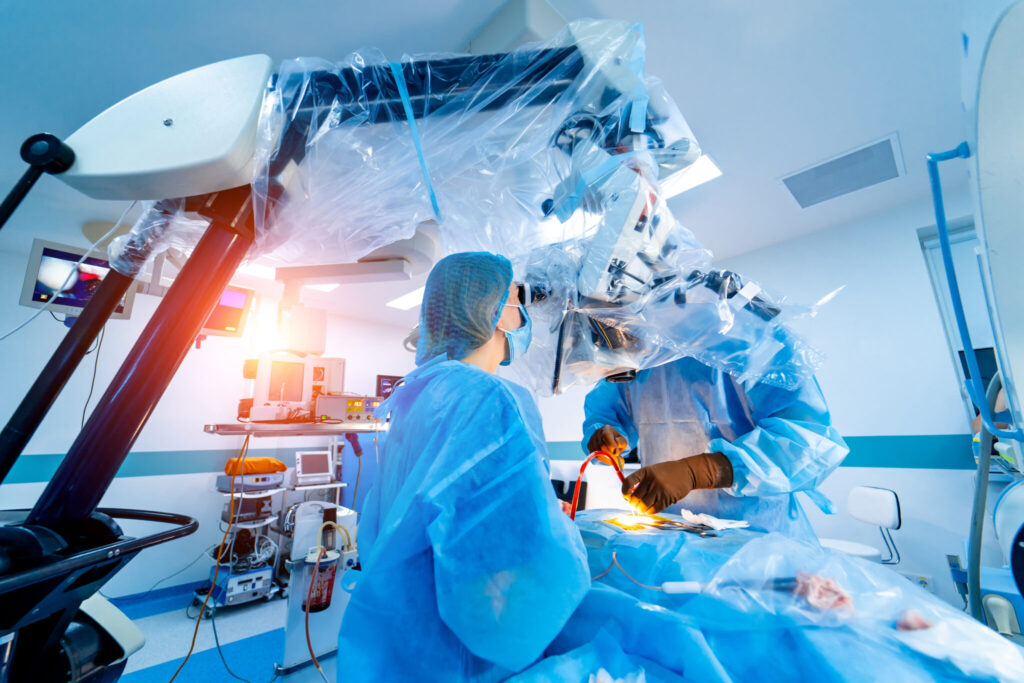DaVinci Robotic Surgery
Services: Robotic surgery
DaVinci Robotic Surgery
Using the most advanced technology available today, the DaVinci Surgical System enables surgeons to perform delicate and complex operations through a few tiny incisions with increased vision, precision, dexterity, and control.
DaVinci Robotic Surgery is a less invasive technique than traditional surgery. With DaVinci Surgery, the cuts (incisions) made in your body by your surgeon are much smaller than the cut made during traditional (also called “open”) surgery.
The DaVinci surgical system gives your surgeon an advanced set of instruments to perform robotic-assisted, minimally invasive surgery.


DaVinci robotic surgery has revolutionized OBGYN Procedures
Your surgeon is in control.
The DaVinci surgical system gives your surgeon an advanced set of instruments to perform robotic-assisted minimally invasive surgery. The term “robotic” often misleads people. Robots don’t perform surgery. Your surgeon performs surgery with DaVinci using instruments that guide via a console.
The DaVinci system translates your surgeon’s hand movements at the console in real time, bending and rotating the instruments while performing the procedure. The tiny wristed devices move like a human hand but with a more excellent range of motion. The DaVinci vision system also delivers highly magnified, 3D high-definition views of the surgical area. The instrument size allows surgeons to operate through one or a few small incisions.
The DaVinci system is one part of a much bigger picture. These include comprehensive and ongoing education, training, and support for surgeons, operating room staff, and hospital care teams. As a patient, you are at the center of a network of dedicated professionals working together to help you get back to what matters most.
There are a number of Key Advantages of DaVinci Robotic Surgery in OBGYN
Precise and minimally invasive:
The robotic system offers increased precision and control during surgeries, enabling OBGYN surgeons to navigate delicate tissues and perform intricate procedures with greater accuracy.
Improved patient outcomes:
The minimally invasive nature of DaVinci robotic surgery leads to shorter hospital stays, reduced blood loss, lower risk of infection, and faster recovery times for women undergoing OBGYN procedures.
Enhanced visualization:
The robotic system provides a three-dimensional, high-definition view of the surgical site, giving OBGYN surgeons a better understanding of the anatomy and facilitating more precise surgical maneuvers.
Reduced scarring:
Compared to traditional open surgeries, DaVinci robotic surgery involves smaller incisions, resulting in reduced scarring and improved cosmetic outcomes for women.
Gynecologic Robotic Surgery Types
- Endometriosis Resection
Endometriosis occurs when tissue that lines the uterus (endometrium) migrates outside the uterus, usually to the area around your reproductive organs, including the ovaries or fallopian tubes. Many women with endometriosis have no symptoms. Although for some women, endometrial tissue patches may swell and bleed with their menstrual cycles, which can cause pain. Endometriosis symptoms may include chronic pelvic pain, heavy menstrual bleeding, pain during sex, pain with bowel movements or urination, and fertility issues.
Surgeons can perform robotic-assisted endometriosis surgeries using DaVinci technology. During endometriosis surgery with a DaVinci system, your surgeon sits at a console next to you and operates using tiny, fully wristed instruments.
A camera provides a high-definition, 3D magnified view inside your body. The DaVinci system translates every hand movement your surgeon makes in real time to bend and rotate the instruments with precision.
- Hysterectomy
A hysterectomy is a surgery to remove the uterus and possibly the ovaries and fallopian tubes. Several conditions may prompt your doctor to recommend a hysterectomy. They range from benign (noncancerous) conditions, like endometriosis or fibroids, to cancer conditions, like endometrial or uterine cancer. While the number of women who receive hysterectomies has declined over the last several decades, approximately 400,000 women in the U.S. still receive hysterectomies yearly.
There are several types of hysterectomy: partial hysterectomy, simple or total hysterectomy, and radical hysterectomy. Your surgeon will discuss what they recommend. This may vary based on your condition, symptoms, and age.
Both simple and radical hysterectomy can be performed with robotic-assisted surgery using DaVinci technology. The system extends surgeon capabilities within minimally invasive surgery.
The DaVinci system makes it possible to perform surgery through a few small incisions about the size of your fingertip. With the DaVinci system, your surgeon sits at a console near you in the operating room. The console enables your surgeon to control a camera and the tiny instruments used to perform your surgery.
The system delivers 3D high-definition views, giving your surgeon a crystal-clear view of the surgical area magnified ten times what the human eye sees. It translates every movement your surgeon makes in real time, bending and rotating instruments that move like a human hand but with a greater range of motion. Built-in tremor filtration technology helps your surgeon move each instrument with smooth precision.
- Myomectomy
Uterine fibroids are benign (noncancerous) growths generally found inside the uterus or its walls. While fibroids may cause no symptoms, some women experience moderate to severe symptoms that significantly disrupt their lives, including pelvic pain, heavy menstrual bleeding, infertility, and miscarriages.
Fibroids are often diagnosed during a routine pelvic exam. To learn more about the size and location of the fibroid tumors, your doctor may have you undergo other tests, such as ultrasonography which uses soundwaves to create images. Doctors can use this information to discuss the best option with you.
Surgeons can perform myomectomies using DaVinci technology. During robotic-assisted fibroid removal surgery with a DaVinci system, your surgeon sits at a console next to you and operates using tiny, fully wristed instruments.
A camera provides a high-definition, 3D magnified view inside your body. The DaVinci system translates every hand movement your surgeon makes in real time to bend and rotate the instruments with precision.
- Pelvic Organ Prolapse
The muscles and connective tissues supporting your pelvic organs (uterus, bladder, and rectum) can weaken, causing the organs to slip down (prolapse) from their usual positions. When pelvic organ prolapse occurs, symptoms may include pressure or discomfort in your pelvic area, a bulge in your vagina, tissue moving out of your vagina, and urinary incontinence.1 Pelvic organ prolapse is surprisingly common. Between 3 and 6 percent of women notice symptoms, and vaginal examinations show that up to 50 percent of women have some degree of pelvic organ prolapse.
Surgeons can perform a type of pelvic organ prolapse repair called a sacrocolpopexy using DaVinci technology. With DaVinci, your surgeon sits at a console next to you and operates using tiny, fully wristed instruments.
A camera provides a high-definition, 3D magnified view inside your body. The DaVinci system translates every hand movement your surgeon makes in real time to bend and rotate the instruments with precision.
What is the DaVinci Surgical System?
The DaVinci Surgical System is a tool that utilizes advanced robotic technologies to assist your surgeon with your operation. It does not act on its own, and your surgeon controls its movements. The DaVinci Surgical System has a 3D high definition (3D-HD) vision system, special instruments, and computer software that allow your surgeon to operate with enhanced vision, precision, dexterity, and control. The 3D-HD image can be magnified up to 10 times, so your surgeon has a close-up view of the area they are operating on. The DaVinci instruments have mechanical wrists that bend and rotate to mimic the movements of the human wrist – allowing your surgeon to make small, precise movements inside your body. DaVinci software can minimize the effects of a surgeon’s hand tremor on instrument movements.
How can it help me?
DaVinci Surgery is a less invasive technique than traditional surgery. With DaVinci Surgery, the cuts (incisions) made in your body by your surgeon are much smaller than the cut made during traditional (also called “open”) surgery. Compared with open surgery, having DaVinci Surgery may offer you:
- A shorter hospital stay
- Less blood loss
- Fewer complications
- Less need for narcotic pain medicine
- A faster recovery
- Smaller incisions for minimal scarring
Does insurance cover DaVinci Surgery?
Surgery with the DaVinci Surgical System is a minimally invasive surgery. Most insurance plans include DaVinci Surgery in their minimally invasive coverage. Major insurance plans cover DaVinci Surgery, including United, Aetna, and Blue Cross Blue Shield. Check with your insurance provider to confirm coverage.
What kinds of surgery can be done using the DaVinci System?
A range of operations can be done using the DaVinci Surgical System, which is commercially available for use in the following specialties:
• Gynecologic Surgery
• Urologic Surgery
• General Surgery
• Cardiac Surgery
• Thoracic Surgery
• Head & Neck Surgery
Is DaVinci Surgery safe?
Over the past decade, hundreds of studies have been published on using the DaVinci Surgical System, demonstrating improved surgical outcomes compared to open surgery. To date, more than 1.5 million surgeries have been per worldwide using the DaVinci Surgical System. Talk with your doctor about all treatment options and the risks and benefits of each. If surgery is the option you choose, talk with your doctor about whether DaVinci Surgery is right for you. Your doctor’s training, experience, and judgment are important factors to consider when making this decision.
Da Vinci surgical systems are comprised of three components:
Surgeon Console
The surgeon's console translates your surgeon’s hand movements at the console in real time, bending and rotating the instruments while performing the procedure.
Patient Cart
The patient-side cart is positioned near the patient on the operating table. It is where the instruments used during the operation move in real time in response to your surgeon’s hand movements at the surgeon console.
Vision Cart
The vision cart makes communication between the system components possible and provides a screen for the care team to view the operation.
Our entire team is dedicated to you
We Help You Navigate Healthcare Decisions With Confidence
We Have Decades of Medical Experience and Providing Compassionate Care.

TEstimonials
What Our Patients Say
What an exceptional experience! I have never been to a nicer medical office. Ever! I was let called in after a second of completing my check in and everyone was so very nice. I wish i knew the name of the assistant that answered all our questions, she was very nice and informative. Don’t hesitate ladies!
The staff and everyone I met on the care team were extremely warm, kind, and knowledgeable. Although visit times are short, they made sure to explain everything thoroughly and made sure I understood. Even though they spoke quickly (lots of info to share in a short 15 minute slot) I never felt rushed or dismissed. I highly recommend this location and especially Dawn.
